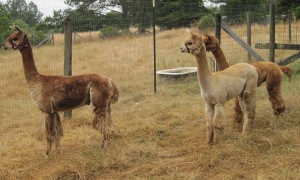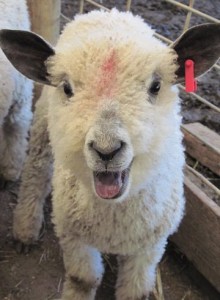It was an absolutely glorious morning. Crisp November sunlight shone through the redwood trees illuminating the golden maples below. I was on my way to visit JoAnn Slissman and her “wonderful felting machine” and to see first hand how she makes her felted wall hangings.
Wyammy Ranch is nestled in the redwood forest above the picturesque town of Occidental. A long, steep driveway takes you past green pastures dotted with coated sheep and up the hill to the ranch. JoAnn has lived on this 30 acre ranch for 50 years and it is here that she raises Championship cutting horses and award winning Romney and Wensleydale sheep.
I have attended many shearing days at Wyammy Ranch and have walked past the felting machine many times, but I have never seen it in action. I was giddy with anticipation!
When I arrive, JoAnn is already hard at work. She is preparing a base for her felted piece with layers of gray wool batting. Each layer is laid so that the direction of the batt fibers is at a ninety degree angle to the previous layer. This allows the fibers to felt together more firmly and help insure that there are no thin spots. She arranges four layers for the base of this wall hanging.
Around JoAnn are her “paints”, bags of colored wool that she sorts through to find the colors she wishes to use. Today she will paint a picture of a sunset that she saw recently on a wilderness ride in Montana. Quickly she cards and teases the colors, laying them out on the gray backing. When the background was to her liking she laid white roving on top to create aspen trees. She added a few details, leaves and bark, a shadow here and there, and the piece is ready to felt. Filling a watering can with hot soapy water, JoAnn wets down the wool. Once wetted it is time to lower the top of the machine, lock it in place and turn it on. I was amazed at how quickly it all went together.
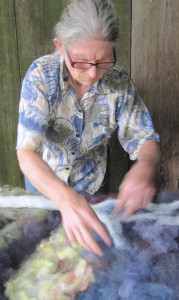
JoAnn designing with colored wool
The machine itself doesn’t look like much. It is a 3 ft. by 4 ft. steel table. Steel legs support a bottom plate which vibrates against a top plate. The top plate, weighing about 100 pounds, holds the wool in place as the machine vibrates.
After twenty minutes the top is unlocked, lifted, and the piece is rotated so that it can be felted in the other direction. Another twenty minutes and the wall hanging is felted. After a quick hosing to get rid of the soap, the piece is ready to dry. JoAnn may add a few details later with a felting needle.
The thing I found interesting about using the felting table is that the piece itself does not shrink. The only thing noticeably smaller is the height of the piece. It was 4 to 5 inches deep before going through the felting process. Now it is about 1/4 inch thick! The details that are put onto the wall hanging remain intact and the finished piece is basically the same size as before the felting procedure.
Fulling is what causes the wool to shrink. Fulling, if desired, would be done by hand after the felting on the machine is complete. For a wall hanging, fulling is generally not necessary. In addition to making wall hangings,smaller pieces such as boots and hats can be made. Several smaller pieces can go into the machine at one time.
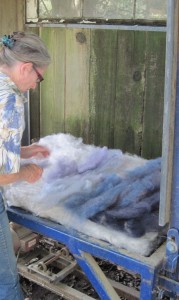
The felting machine is ready to close
I have done some felting myself this past year and have found that it can be physically taxing. In addition to keeping the details intact, the felting machine also did the work, allowing the artist to be just that…an artist. It would be possible to make several of these wall hangings at once without collapsing in a heap at the end of the day.
I spent an inspiring morning with JoAnn and would love to try my hand at making a wall hanging myself…H’mmm…redwood trees with sunlit maples…
JoAnn Slissman has been artistically encouraged since she was able to hold a crayon. First by her mother, who was a trained artist, and later by spending her Saturdays at the Josephine D. Randall Junior Museum in San Francisco where she was exposed to arts, crafts, weaving, painting and so forth. As a high school senior, she attended The California Art Institute on Saturdays. Then it was on to Berkeley where she earned a B.A. in art, specializing in painting.
Concurrently, the family moved to the ranch where they raised Quarter Horses. In 1984, JoAnn took Lydia VanGelder’s spinning and dyeing class at SRJC. She was hooked on wool! There wasn’t much wool available locally for handspinners so she bought some sheep. As the flock grew, she began selling wool and sheep to others. Since she is raising the sheep for hand spinning, almost all of her flock wear coats to keep the fleece as clean as possible.
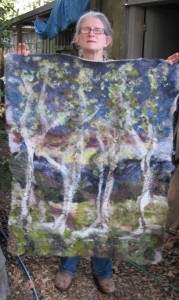
The finished piece
A friend had a felting table that she had purchased from a Canadian company and JoAnn started using it to make saddle pads for her horses. When her friend moved to Texas, JoAnn bought the table. She had lots of wool to use up and felt uses a lot of wool. She produced plenty of saddle pads. However, it wasn’t long before her artistic background came to the forefront. Her first pictorial felt piece was a landscape. She was on her way. She could paint with wool!
To produce her color palette, JoAnn dyes fleeces in big pots on her wood stove. She puts several colors in each pot which gives her a range of colors to choose from. If she felts a garment, she spins up the same wool so that the knit edging will harmonize. Her choice of dyes are chemical-Cushing, Jaquard, and she still has some Deka dyes.
If this sounds like something you would like to try, JoAnn does rent time on the felting machine, and she can instruct, and supply materials as well. Contact JoAnn at info(at)wyammyranch.com
